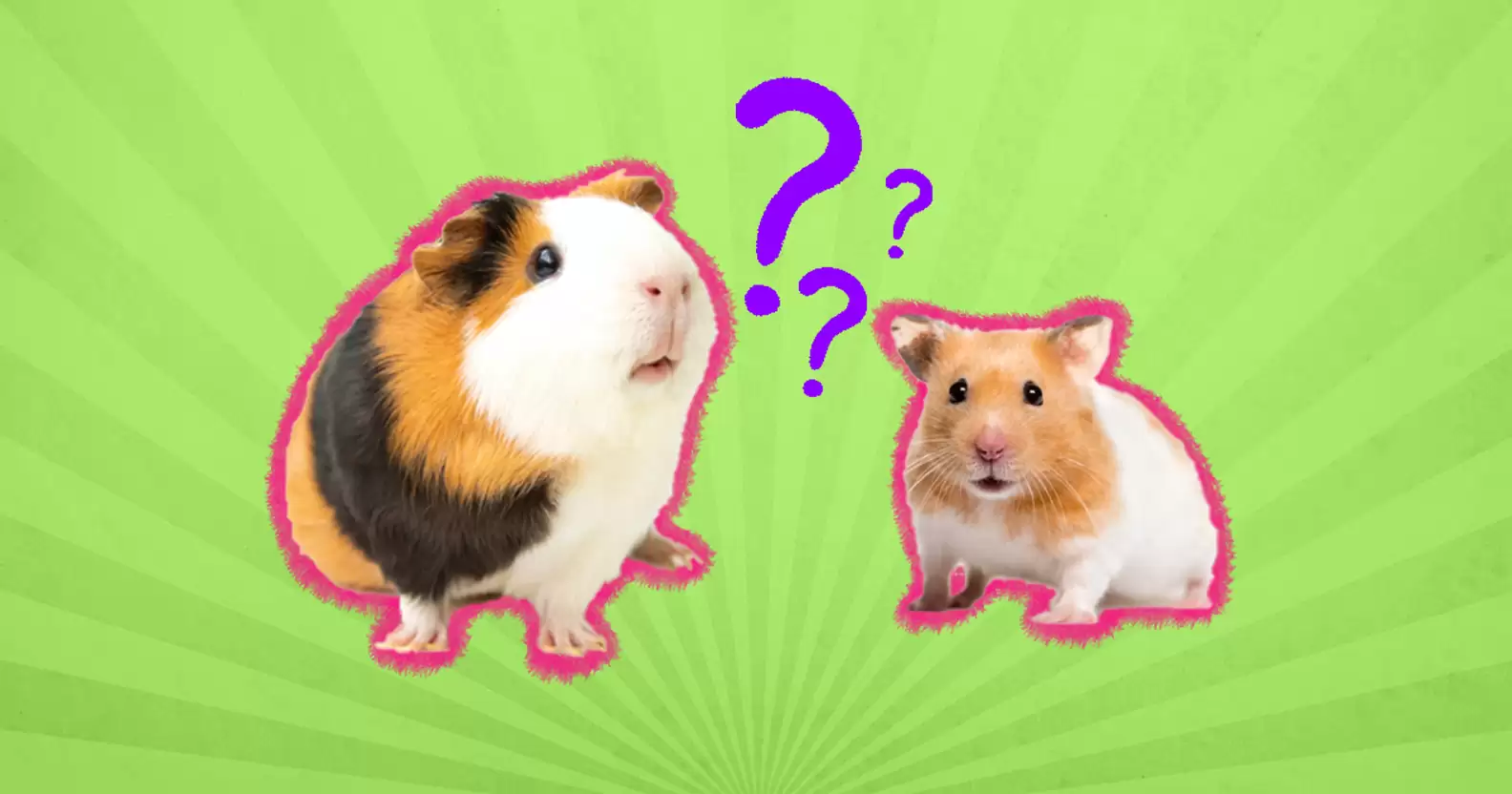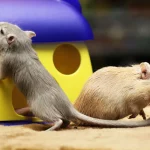Young people like to have hamsters as pets. They don’t need much care, and even though they can get out of their cages, they probably won’t do much damage to a home.
The guinea pig is another kind of small rodent that fits the bill for a small furry pet. They are known for “popcorning” and chirping, which is surprising for how social they are.
Know the differences between a hamster and a guinea pig before you get one as a pet.
Don’t worry, we’ll tell you what makes these animals different from each other. By the end of this, you’ll know what makes these two animals different from each other.
Comparing a Hamster and a Guinea Pig
| Hamster | Guinea Pig | |
| Size | Weight: 3.5oz to 10.5oz Length: 2in to 14in | Weight: 1lb to 3.5lbs Length: 8in to 16in |
| Social Nature | They do well and often prefer to be alone due to resource scarcity. | Social animals do better in pairs or small herds. |
| Food Preference | Omnivore | Herbivore |
| Waking Period | Nocturnal | Partially nocturnal and diurnal |
| Lifespan | 2 to 4 years with many variances according to breed | 3 to 8 years |
| Offspring | – Babies are born both sightless and hairless – Litters as large as 20 pups | – 2-4 pups – Highly capable young that can move, see, and has teeth |
The Key Differences Between Hamsters and Guinea Pigs
The biggest differences between hamsters and guinea pigs are how big they are, how friendly they are, and what they like to eat.
Guinea pigs are a lot bigger than hamsters. Guinea pigs weigh a few pounds, while hamsters don’t even weigh a pound.
Also, guinea pigs are very social animals and should be kept in a cage with other guinea pigs. Hamsters, on the other hand, are mostly solitary and can do well on their own.
Lastly, hamsters are omnivores, which means they will eat anything, even insects, but guinea pigs are strict herbivores and won’t eat any other animals.
These differences make it easy to choose between the two animals as a pet.
Hamster vs. guinea pig: Behavior and life span
Many people who have never had a pet before choose hamsters because they are small. With the right training, handling, and socialization, hamsters can be cuddly and friendly.
However, hamsters can fight, so it’s best to only keep one per cage. Hamsters are also nocturnal, so be ready for your new furry friend to be running on his exercise wheel and making noise at night.
If you have trouble sleeping, you might want to keep your hamster in the living room instead of your bedroom.
Hamsters don’t live for very long, which is a shame. Most pets only live for two to three years, which can make it hard for kids to say goodbye.
Guinea pigs live much longer than most other animals. On average, they live from four to eight years. They are also very social, which means that you can keep pigs of the same gender in the same cage.
Guinea pigs are bigger than hamsters, so they will need more space in their cage.
Your guinea pig can learn to sit on your lap or enjoy spending time with you if you spend time with it.
Guinea pigs sleep a lot, both during the day and at night, and when they aren’t sleeping, they are busy.
Hamster vs Guinea Pig: Size
The guinea pig is a lot bigger than the hamster. A guinea pig can grow to be 16 inches long, but it doesn’t have a tail. A hamster can grow to be about 14 inches long, including its tail.
Guinea pigs can weigh up to 3.5 pounds, while hamsters usually weigh between 3.5 and 10.5 ounces. Guinea pigs are pretty big pets, so they need a lot of space in their cages.
Hamster vs Guinea Pig: Social Nature
Hamsters don’t have as many friends as guinea pigs do. Hamsters live in dry, arid places all over the world, so they are built to survive when there isn’t enough food.
Because of this, many kinds of hamsters aren’t very social because they prefer to keep their food to themselves. Even so, that doesn’t mean you can’t have more than one hamster.
Guinea pigs are naturally social animals that like to live in small groups. These animals live in groups and have complex relationships with each other.
When people buy guinea pigs as pets, getting just one is a big mistake. For these animals to do well, they need to be around other animals.
Hamster vs Guinea Pig: Food Preference
Hamsters eat both plants and animals, while guinea pigs only eat plants. Hamsters eat mostly plants, but people have seen them eat mealworms and other insects to get more protein.
But these animals don’t need a lot of protein, so if you give your pet hamster the right food, you won’t have to feed it bugs at all.
Guinea pigs are just animals that eat plants. They will only eat plants, such as different kinds of hay. Good guinea pig food will give them all the vitamins and minerals they need to stay alive and grow.
Hamster vs Guinea Pig: Sleeping patterns
Hamsters and guinea pigs also have different sleeping patterns.
Hamsters are nocturnal, so they won’t be up much during the day, and you might get woken up by your hamster rustling around in his cage at night.
“This may be disturbing for their owners and will also mean they won’t be as willing to play during the day,” Dr. Bonk said.
Guinea pigs are crepuscular, which means they’re most active at dawn and dusk — so you could get woken up by your guinea pig, too. But guinea pigs typically only take naps and are awake for most of the day.
Hamster vs Guinea Pig: Space
Although hamsters are more active than guinea pigs, their cage size doesn’t have to be as big. But keep in mind that they do need to live indoors.
Guinea pigs, on the other hand, need lots of space where they can play and forage, and while they do well living inside, they are much better suited to an outdoor hutch with a run.
Hamster vs Guinea Pig: Sociability
How social they are is a big difference between hamsters and guinea pigs. Hamsters are happier when they are on their own, but guinea pigs are social and do best when there are two or more of them.
Another thing to think about is that guinea pigs have the same schedule as you. In other words, they sleep at night and are awake during the day.
But hamsters are nocturnal, which means they sleep during the day and do a lot of work at night.
What About Health Issues?
As with any pet, Guinea Pigs and Hamsters need to be looked after properly to avoid health issues.
On the whole, Guinea Pigs are remarkable easy-care pets with few health issues provided they are kept well-fed and watered and housed in clean, dry conditions.
The life expectancy of Guinea Pigs is between 5 and 7 years.
Hamsters may develop a serious condition known as a ‘wet tail’. It is particularly common in very young ‘Syrian’ Hamsters but it may affect other Hamster species too.
It is characterized by foul smelly watery diarrhea, dirty wet anal and tail area, loss of appetite and coat condition, and infections. If left untreated it may quickly result in the Hamster’s death.
Hamsters may also develop a range of skin conditions or be hosts to a number of parasitic worms, mites, and fungal infections. Hamsters will usually live for between 2 and 3 years.
Hamsters, Guinea Pigs, and Gerbils may also carry some particularly serious zoonotic diseases that pose a real risk to humans.
These include:
- Hantavirus
- Leptospirosis
- Lymphocytic choriomeningitis (LCMV)
- Tularemia
- Salmonella
Choosing Guinea Pigs vs Hamsters
In the end, your choice of a pet depends on what you like best, and while their care needs are different, they also have many things in common.
Even though both pets are popular with kids, an adult needs to be in charge of their daily care, especially with younger kids.
It’s also important to think about how old the children are and how well they can handle animals.
Hamsters aren’t the best choice for very young children unless an adult will be handling them.






